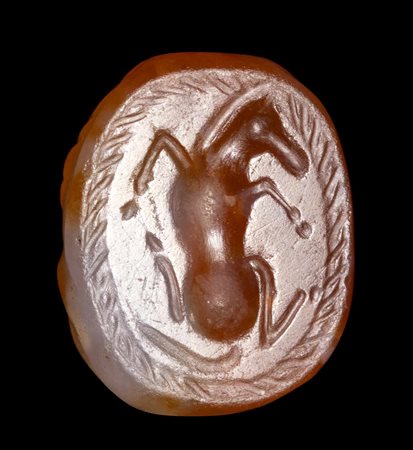 Bertolami Fine Art - Piazza Lovatelli 1, 00186 Roma
Bertolami Fine Art - Piazza Lovatelli 1, 00186 Roma
ASTA 267 - GLITTICA ASTA 267 - GLITTICA
venerdì 7 luglio 2023 ore 12:30 (UTC +00:00)
AN ETRUSCAN CARNELIAN SCARAB. A ROLLING HORSE.
AN ETRUSCAN CARNELIAN SCARAB. A ROLLING HORSE.
5th - 4th century B.C.
10x13x7 mm
Horses, mules and donkeys rolling on the ground are not uncommon on Greek and Etruscan gems. As Furtwangler suggests, they may have had a connotation of good luck; or the subject appealed as lending itself to an interesting composition in the elongated field of the gems. In that stone, the body is seen from beneath, the head with the neck in profile turned to the right, the legs are open in different directions. Hatched border. Wear marks. As Boardman said, the subject is surprising. Fallen horses are seen on Archaic vases, but then generally as part of a chariot team that has come to grief. It appears as an isolated motif in major art a little later, however in Polygnotos'wall painting of the Sack of Troy in a building at Delphi: Pausanias describes "a horse who seems about to roll in the dust" .
J. Boardman, D. Scarisbrick, The Ralph Harari collection of finger rings, p. 13 n. 3; G.M. Richter, The engraved gems of the greek, Etruscans and Romans p. 71 n. 207-209.
Provenance: From a private collection, France, acquired on the art market in the early 2000s





